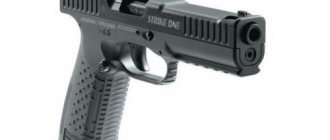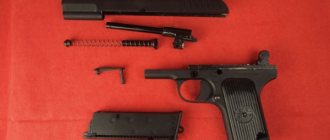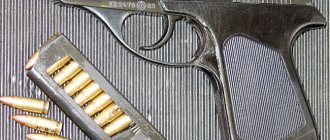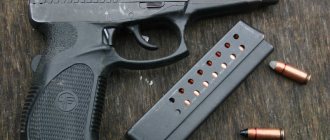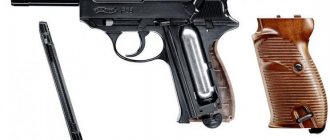Small arms, ammunition, devices and accessories of the 19th-21st centuries
The site is a private collection of materials on the topic “firearms and ammunition” and is an amateur information and educational weapons portal. All information was obtained from open sources. The administration does not claim authorship of the materials used - all rights belong to their owners. The administration is not responsible for the use of information, facts or opinions posted on the site.
- Account Registration
- Weapon
- home
- Rules
Frommer Fämbru Pisztoly 37.M (1937 Minta)
Appearing a year after his death, Rudolf Frommer's last design was an improved Model 1929 in 9mm Short chambering. Frommer's actual involvement in the design of this model was believed to be limited. The pistol was adopted by the Hungarian Army as the '37M.' The principal difference between the 1937 and 1929 patterns lies in the abandonment of pinned-in cocking grips at the rear of the slide in favor of conventional grooving. The later gun also has a smaller hammer and an additional finger-rest on the toe of the butt. A Frommer-type grip lever provided the only safety device. The grips are wood. The pistol was also manufactured for a German Contract under the designation of Pistole 37(u) or 'P37'.
Frommer 37M Assembly Drawing and Parts ListFrommer 37M Large Detailed Assembly DrawingFrommer 37M Disassembly Instructions
The slide is marked: FйMBRU- FEGYVER ИS GИPGYБR RT 37M. Some time after serial 222478 the dash after 'FEGYVER' was dropped in the spelling. Please check your 37.M pistols with higher than 222478 serials if they have this dash or not.
Standard Hungarian Army acceptance mark located on the left side of the trigger guard.
St. Stephen's Crown acceptance mark on the left side of the trigger guard. Believed to be a non-military Hungarian mark: police/civilian/export mark.
An alternate Hungarian Army acceptance mark on the right side of the trigger guard. E = Elfogadva (Accepted). More commonly found on wartime Hungarian military rifles.
| 7-round detachable box magazine. All original magazines have the finger-rest. The bottom of the original magazines are marked '37M'Frommer 37M Magazine Details |
| Standard Frommer 37M straight grooved grip is shown on the far left. An alternate, possibly after market grip is shown next. |
| A Frommer 37M leather holster |
| Leather holsters makers' stamps. “BCRGYBR” (Leather Factory), shown on the far left, 'Mauthner' shown next. |
| A different style Hungarian 37M leather holster. Photos courtesy of Al Gerth |
It appears that the 37M serial numbering continued the 29M serials approx. from 50000
Estimated serial number ranges, : 1937 C1 — C1262 (prototypes with unique serials — see below) 1938 50000 — 51000 1939 51001 — 60000 1940 60001 — 100000 1941 100001 — 150000 1942 150001 — 180000 1943 180001 - 210000 1944 210001 - 245600 1944 C- 111800 - C-115700 (post German-Contract wartime mfg - see below)
Observations contributed by Dave Ong (thank you): – The early pistols had lightening cuts on the barrel that were dropped around 80,000. – The pistols had a circle K proof on the muzzle until around 82,000, then changed to a circle E proof, which proof was eliminated around serial number 200,000. – The crown proof was dropped from the barrel around 200,000 – The short St Stephan proof was on pistols until around 190,000, then it was changed to the tall St Stephen proof. – Somewhere around 234,000 the St Stephan proof is dropped for a FEG shield, and older barrels with lightening cuts and crown proofs are recycled in production with new circle E proofs? – One pistol, serial 196243 was reported with no dash after FEGYVER. – One quality nickeled pistol has engraving from Austria. Probably something the GIs were having done locally in Austria post war to their souvenirs.
Pistol Frommer Stop
March 25th, 2013
| 08:50 pm - Pistol Frommer Stop Pistol Frommer Stop is living proof that the gloomy Teutonic genius is nothing compared to the much gloomier Magyar genius...Rudeolf Frommer is a very remarkable personality in itself. The son of a textile merchant and the grandson of a rabbi first went into business. He graduated from the Commercial Academy and began working on the stock exchange. After that, he went to work at Credit Bank. When the FEG arms factory received a fur-bearing animal, Frommer was sent by the banking authorities to the factory as a financial director to oversee the bankruptcy procedure. After the reorganization of the plant, Frommer remained as financial director. As a result of his successful marriage to Leona Kornfield, daughter of Sigmund Confield (one of the richest people in Hungary, owner of the Credit Bank and his immediate superior), Frommer entered the Hungarian high society. In general, as in the proverb - don’t have a hundred friends, but marry like Adzhubey. Since the FEG company de facto belonged to Credit Bank, the finder appointed by the bank was the king and god at the plant. Gradually Frommer decided to become a brilliant and world-famous gunsmith designer. But it turned out badly - his first patents were rejected. In the end, having reworked the Browning system of automatic operation with a long barrel stroke, he received patent #17324 on August 19, 1899. From this moment Frommer the gunsmith began. Different historians view his activities as a designer very differently. Some believe that he actually designed weapons, but many believe that he simply ran the design bureau and took out patents in his name. Fortunately, the position allowed - in 1903 Frommer became chairman of the board of directors of the plant. Having considerable financial and political weight, he pushed for the adoption of his Frommer Stop pistol by the Hungarian Army in 1912, which became known as the M12. By the way, the main competitors in the competition were Browning 1900 and Browning 1910, which were exactly half the price and twice as reliable, but... A furry paw is such a thing. Continued tomorrow. |
| jurgen_m |
| March 26th, 2013 07:33 am (UTC) |
And this device is quite up to par, compact, convenient... But with such a locking, you could almost put a Parabellum cartridge in there, albeit with modifications. And so - a curiosity.
(Reply) (Parent) (Thread)
| artmolk |
| March 26th, 2013 07:40 pm (UTC) |
loading from a clip, without a magazine, is not so bad for the army. combat readiness is higher due to the inability to screw up this store)
(Reply) (Parent) (Thread)
| jurgen_m |
| March 26th, 2013 09:05 pm (UTC) |
Well, let’s put it this way: there were already many shops then, but ten years later they were all over the place. And they solved the problems with the failures. Moreover, there are two magazines in a set, so the failure of one is not critical, and no one has canceled the group spare parts. But the magazine does not turn into a dirt collector, and if it is damaged, it is simply replaced and that’s all. About spare parts above. But failure to cut off cartridges in a non-removable magazine is critical. In addition, loading a magazine with cartridges without a clip is very cumbersome, and even if the clips come with the loaded cartridges, it is not a gun. If only because a de facto disposable clip costs money and its weight affects the weight of the closure.
And the cartridge in the clip is less protected from contamination than the cartridge in the magazine.
(Reply) (Parent) (Thread)
| shurik_sas |
| March 26th, 2013 08:24 am (UTC) |
>Eventually reworking the Browning system of automatic operation with a long barrel stroke—
Is this Browning Auto 5?
| mihaly4to6a |
| March 26th, 2013 05:15 pm (UTC) |
Good day. I looked at the section provided by Pavlov, and a question arose - does it happen that the precision of manufacturing/articulation also allows for pneumatic damping? Due to a change in volume in the valve return spring tube?
| grozab |
| March 26th, 2013 08:12 pm (UTC) |
No, there are such gaps there - a match will fit through. This is not Marvil-Hilbert...
(Reply) (Parent) (Thread)
| Vsevolod Gluhovtsev |
| August 13th, 2020 04:35 pm (UTC) |
Better late than never) Having accidentally stumbled upon the combination “gloomy Magyar genius”, I remembered the “Ikarus” with a “lying” engine under the floor.
DB-2 (ANT-37) Dimensions. Engine. Weight. Story. Range of flight
In the fall of 1934, OKB A.N. Tupolev receives the task of building the ANT-37 (DB-2) long-range bomber. Due to changed military requirements, the long-range bomber had to have a range of at least 3,000 km and reach a maximum speed of at least 350 km/h. Designer P.O. was appointed head of the topic. Sukhoi, who already has experience in developing the ANT-25 and ANT-36 aircraft. The aerodynamic design of the project was based on the design of previous Sukhoi aircraft with a high aspect ratio wing and a relatively small load on the wing.
During construction, individual parts and assemblies of serial ANT-36 were used. Like the ANT-25, the aircraft's wing was made of corrugated aluminum, with the corrugation recess filled with balsa and the planes lined with fabric. The aircraft was designed for Mistral-Major engines with a power of 800 hp. The aircraft was equipped with two rotating turrets with machine guns: one in the nose, the other behind the cockpit. At the beginning of 1935, the layout was approved, and after half a year the aircraft was completed. On June 16 of the same year, test pilot K.K. Popov made the first flight on it. After factory tests, the prototype aircraft was transferred to the state ones. On July 20, the plane crashed, two crew members escaped by parachute, one died. The cause of the disaster was vibration of the tail, as a result of which the rear part of the fuselage fell off. When building the second copy, all errors were taken into account; wing fairings were made on it, and the fuselage was reinforced with stiffening ribs on the stabilizer. On February 25, 1936, the ANT-37bis aircraft made its first flight. On August 20, 1936, the crew of M.Yu. Alekseeva made a non-stop flight along the route Moscow - Omsk - Moscow with a length of 4955 km in 23 hours 20 minutes. In February 1937, the vehicle was transferred to the Air Force Research Institute for testing, where tail vibration was again discovered. In this regard, the Air Force command removed the aircraft from testing, and further work on the bomber was stopped.
Serial production of DB-2 (ANT-37) aircraft began at plant No. 18, where two aircraft were laid down, but at the beginning of September 1936, work on them was stopped. One of the aircraft was transferred to the Design Bureau at Plant No. 156, where it was completed as a record aircraft. More powerful M-86 engines were installed on it, the forward part of the fuselage was re-equipped, additional fuel tanks were installed, and all small arms and bomber weapons were removed. New three-bladed variable pitch propellers were installed. The plane was named “Motherland” and was prepared for record flights. On September 24, 1938, from the Monino airfield, the Rodina plane headed east. He was supposed to make a non-stop flight from Moscow to Khabarovsk. The car was piloted by a female crew headed by BC Grizodubova, the co-pilot was P.D. Osipenko and navigator M.M. Raskova. By that time, Polina Osipenko had already set several world records on the MP-1 seaplane designed by G.M. Beriev. The plane flew a distance of 5947 km in 26 hours 29 minutes at an average speed of 224 km/h. The flight ended with a landing with the landing gear retracted near Komsomolsk-on-Amur. The crew set a world flight distance record for women.
Pistol Frommer Stop
In 1912, the Frommer “Stop” pistol was adopted by the Hungarian Honved, an integral part of the armed forces of Austria-Hungary (some sources also use the designation of this pistol as M12). The Frommer “Stop” pistol chambered for 7.65 mm caliber was developed and patented by the Hungarian inventor Rudolf Frommer. This Frommer pistol embodies a new approach to the use of a long barrel stroke. The main innovation was the use of a system of two springs located above the barrel in a special tunnel channel. One of the springs was connected to the moving bolt, and the second absorbed the recoil energy of the barrel and returned it to the extreme forward position.
The use of two springs is very typical for automation based on a long barrel stroke, when the barrel and bolt move independently of each other. In particular, in Frommer's 1901 design, both springs were put on the barrel and bolt, respectively.
By placing the springs above the barrel, Frommer made the weapon more difficult to maintain, but at the same time made the pistol more compact. At the moment of the shot, the barrel of the Frommer “Stop” pistol was locked by a rotating bolt cylinder, which consisted of two parts. The inertial hammer was driven by an open hammer.
The only fuse was a frame fuse.
Before disengagement, the bolt and barrel together traveled a distance of approximately one inch. After this, the bolt was held in place, and the barrel returned to the forward position, while extracting and ejecting the spent cartridge case.
Then the shutter began to move forward; he sent a new cartridge into the barrel and locked the chamber by turning the cylinder. The weapon is fed from a detachable magazine with a capacity of 7 rounds. Simple sighting devices consist of a front sight and rear sight.
In addition to the army of Austria-Hungary, Frommer “Stop” pistols were exported to Germany, Bulgaria and Turkey during the First World War.
After the end of the First World War and the collapse of Austria-Hungary, this pistol was adopted by the newly formed army of independent Hungary in 1919 under the name M19.
In addition to the army, the Frommer “Stop” pistol with the official designation M19 was adopted by the police, gendarmerie and secret police.
The pistol was used by the Hungarian army and police until 1945, although theoretically it was considered replaced by more advanced models.
Pistols chambered for the 7.65 mm cartridge certainly had a stamp on the front of the safety guard, confirming its acceptance for official use. This stamp consists of the Latin letters “Вр” (for Budapest), the coat of arms of Hungary or Austria-Hungary and two numbers indicating the year of issue.
After 1919, a modification of the Frommer “Stop” pistol chambered for the 9x17 cartridge also went on sale, differing from the basic version only in caliber. There are no official marks on these samples. The production of Frommer “Stop” pistols began in the early 1910s at the Hungarian enterprise Fegyver es Gepgyar Rt. (FEG) in
In addition, in the late 1930s, a 9-mm version of the Frommer “Stop” pistol with the designation M39 was proposed for export, but the project of this weapon was curtailed due to the outbreak of World War II.
The Frommer "Stop" pistol was one of the few pistols with a long automatic recoil mechanism to achieve success. However, the question remains open why such a system was needed in a pistol that used a 7.65 mm caliber cartridge.
Even the use of 9-mm caliber cartridges could not cause the pistol to use such a complex shutter delay system.
Despite the complex design of this weapon and its awkward appearance, the pistol was made of high-quality materials, was convenient and reliable to use, enjoyed a good reputation and at one time became widespread in Central Europe.
Technical characteristics of the Frommer Stop pistol
- Caliber: 7.65×17 (.32 ACP) / 9x17 (.380 ACP)
- Weapon length: 165 mm
- Barrel length: 100 mm
- Weight without cartridges: 610 g
- Magazine capacity: 7 rounds
Shooting from a Frommer Stop pistol
Historical reference
Main article
:
History of the M37
The new M37 self-propelled gun, designed to complement or replace the M7 self-propelled howitzer, in contrast to which it had a more advanced base from the M24, providing increased mobility, increased ammunition and reduced weight, was put into service in November 1944. The M37 had an elongated fighting compartment open at the top with vertical sides. The M4 howitzer with a caliber of 105 mm was installed in front of the fighting compartment and was covered with a massive mask. American Car & Foundry received a contract to produce 448 cars, but built 316, most of them delivered after the war, when Cadillac joined the contract. The crew and crew of the M37 consisted of 7 people, weight - 18,143 kg, length -5.54 m, air angle from + 45° to - 10°, angle angle - 22.5° left and right, ammunition - 90 rounds. The practical rate of fire reached 2-3 rounds per minute, the firing range of a high-explosive fragmentation projectile weighing 14.57 kg was 11,250 m. To the right of the gun was mounted a high commander's turret, on which a 12.7-mm anti-aircraft machine gun was mounted on a bracket.

